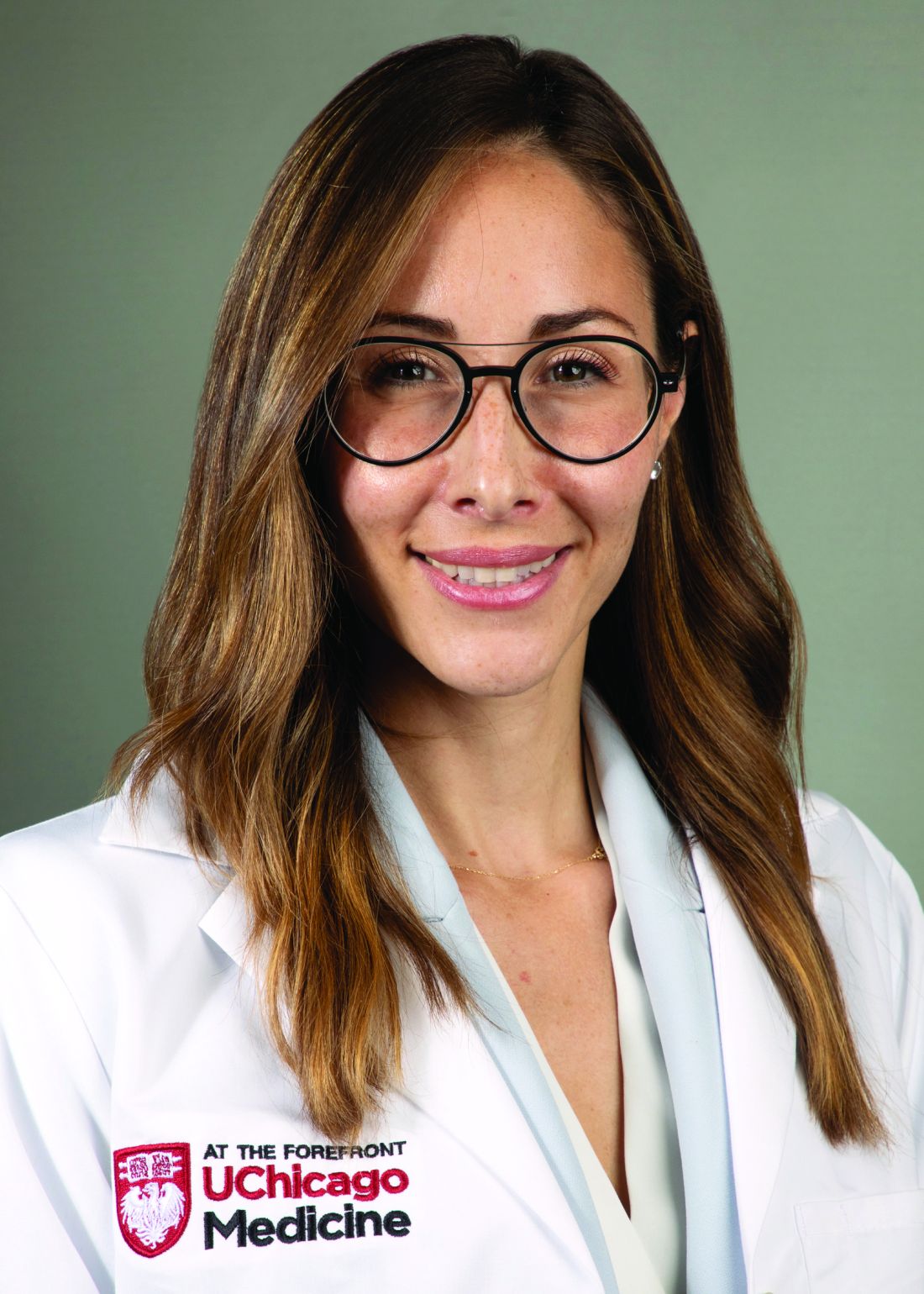User login
, according to a small retrospective analysis.
“Current disease monitoring tools have significant limitations,” said Noa Krugliak Cleveland, MD, director of the intestinal ultrasound program at the University of Chicago. “Intestinal ultrasound is an innovative technology that enables point-of-care assessment.”
Dr. Cleveland presented the findings at the October 2023 American College of Gastroenterology’s annual scientific meeting in Vancouver, Canada.
The analysis was based on 30 patients with IBD in an ongoing real-world prospective study of upadacitinib (Rinvoq, Abbvie) who were not in clinical remission at week 8. For 11 patients, routine clinical care included IUS; the other 19 patients were monitored using a conventional approach.
In the study, both groups were almost evenly split in terms of diagnosis. In the IUS group, four patients had Crohn’s disease and five had ulcerative colitis. In the conventional management group, six had Crohn’s disease and five had ulcerative colitis.
The primary endpoint was time to treatment change.
For the secondary endpoint, the researchers defined clinical remission as a Simple Clinical Colitis Activity Index ≤ 2, or Harvey-Bradshaw Index ≤ 4, and by IUS as bowel wall thickness ≤ 3 mm in the colon or terminal ileum and no hyperemia by color Doppler signal.
The average time to treatment change in the IUS group was 1.1 days, compared with 16.6 days for the conventional management group, Dr. Cleveland reported.
The average time to clinical remission was 26.8 days for the IUS group, compared with 55.3 days for the conventional management group.
The delays in treatment change in the conventional management group were attributed to awaiting test results and endoscopy procedures, as well as communications among clinical team members.
Strength of this research project included its prospective data collection and the experienced sonographers who participated, Dr. Cleveland and colleagues said. Limitations included retrospective analysis, a small number of patients on a single therapy, and the potential for bias in patient selection. Studies of other therapies and a prospective trial are underway.
During the presentation, Dr. Cleveland commented about what kinds of treatment changes were made for patients in the study. They commonly involved extending the induction time, and, in some cases, patients were switched to another treatment, she said.
In an interview, Michael Dolinger, MD, of the Icahn School of Medicine at Mount Sinai in New York, said more research needs to be done to show whether IUS will improve outcomes.
“They’re showing that they make more changes sooner,” he said. “Does that actually affect and improve outcomes? That’s the big question.”
Dr. Dolinger said the concept for using IUS is that it helps physicians catch disease flares earlier and respond faster with changes to the treatment plan, thus preventing the buildup of chronic bowel damage.
“That’s the concept, but that concept is actually not so proven in reality” yet, he said. “But I do believe that they’re on the right path.”
In Dr. Dolinger’s view, adding ultrasound provides a more patient-centric approach to care of people with IBD. With more traditional approaches, patients often are waiting for results of tests done outside of the visit, such as MRI.
“With ultrasound, I am walking them through the results as it’s happening in real time during the clinic visit,” Dr. Dolinger said. ”I am showing them on the screen, allowing them to ask questions. They’re telling me about their symptoms, as I’m putting the probe on where it may hurt, as I’m showing them inflammation or healing. And that changes the whole conversation.”
The study received support from the Mutchnik Family Foundation. Dr. Cleveland reported financial relationships with Bristol Myers Squibb, Neurologica, and Takeda. Her coauthors reported financial relationships with multiple drug and device makers. Dr. Dolinger said he is a consultant for Samsung’s Neurologica Corp., which makes ultrasound equipment.
, according to a small retrospective analysis.
“Current disease monitoring tools have significant limitations,” said Noa Krugliak Cleveland, MD, director of the intestinal ultrasound program at the University of Chicago. “Intestinal ultrasound is an innovative technology that enables point-of-care assessment.”
Dr. Cleveland presented the findings at the October 2023 American College of Gastroenterology’s annual scientific meeting in Vancouver, Canada.
The analysis was based on 30 patients with IBD in an ongoing real-world prospective study of upadacitinib (Rinvoq, Abbvie) who were not in clinical remission at week 8. For 11 patients, routine clinical care included IUS; the other 19 patients were monitored using a conventional approach.
In the study, both groups were almost evenly split in terms of diagnosis. In the IUS group, four patients had Crohn’s disease and five had ulcerative colitis. In the conventional management group, six had Crohn’s disease and five had ulcerative colitis.
The primary endpoint was time to treatment change.
For the secondary endpoint, the researchers defined clinical remission as a Simple Clinical Colitis Activity Index ≤ 2, or Harvey-Bradshaw Index ≤ 4, and by IUS as bowel wall thickness ≤ 3 mm in the colon or terminal ileum and no hyperemia by color Doppler signal.
The average time to treatment change in the IUS group was 1.1 days, compared with 16.6 days for the conventional management group, Dr. Cleveland reported.
The average time to clinical remission was 26.8 days for the IUS group, compared with 55.3 days for the conventional management group.
The delays in treatment change in the conventional management group were attributed to awaiting test results and endoscopy procedures, as well as communications among clinical team members.
Strength of this research project included its prospective data collection and the experienced sonographers who participated, Dr. Cleveland and colleagues said. Limitations included retrospective analysis, a small number of patients on a single therapy, and the potential for bias in patient selection. Studies of other therapies and a prospective trial are underway.
During the presentation, Dr. Cleveland commented about what kinds of treatment changes were made for patients in the study. They commonly involved extending the induction time, and, in some cases, patients were switched to another treatment, she said.
In an interview, Michael Dolinger, MD, of the Icahn School of Medicine at Mount Sinai in New York, said more research needs to be done to show whether IUS will improve outcomes.
“They’re showing that they make more changes sooner,” he said. “Does that actually affect and improve outcomes? That’s the big question.”
Dr. Dolinger said the concept for using IUS is that it helps physicians catch disease flares earlier and respond faster with changes to the treatment plan, thus preventing the buildup of chronic bowel damage.
“That’s the concept, but that concept is actually not so proven in reality” yet, he said. “But I do believe that they’re on the right path.”
In Dr. Dolinger’s view, adding ultrasound provides a more patient-centric approach to care of people with IBD. With more traditional approaches, patients often are waiting for results of tests done outside of the visit, such as MRI.
“With ultrasound, I am walking them through the results as it’s happening in real time during the clinic visit,” Dr. Dolinger said. ”I am showing them on the screen, allowing them to ask questions. They’re telling me about their symptoms, as I’m putting the probe on where it may hurt, as I’m showing them inflammation or healing. And that changes the whole conversation.”
The study received support from the Mutchnik Family Foundation. Dr. Cleveland reported financial relationships with Bristol Myers Squibb, Neurologica, and Takeda. Her coauthors reported financial relationships with multiple drug and device makers. Dr. Dolinger said he is a consultant for Samsung’s Neurologica Corp., which makes ultrasound equipment.
, according to a small retrospective analysis.
“Current disease monitoring tools have significant limitations,” said Noa Krugliak Cleveland, MD, director of the intestinal ultrasound program at the University of Chicago. “Intestinal ultrasound is an innovative technology that enables point-of-care assessment.”
Dr. Cleveland presented the findings at the October 2023 American College of Gastroenterology’s annual scientific meeting in Vancouver, Canada.
The analysis was based on 30 patients with IBD in an ongoing real-world prospective study of upadacitinib (Rinvoq, Abbvie) who were not in clinical remission at week 8. For 11 patients, routine clinical care included IUS; the other 19 patients were monitored using a conventional approach.
In the study, both groups were almost evenly split in terms of diagnosis. In the IUS group, four patients had Crohn’s disease and five had ulcerative colitis. In the conventional management group, six had Crohn’s disease and five had ulcerative colitis.
The primary endpoint was time to treatment change.
For the secondary endpoint, the researchers defined clinical remission as a Simple Clinical Colitis Activity Index ≤ 2, or Harvey-Bradshaw Index ≤ 4, and by IUS as bowel wall thickness ≤ 3 mm in the colon or terminal ileum and no hyperemia by color Doppler signal.
The average time to treatment change in the IUS group was 1.1 days, compared with 16.6 days for the conventional management group, Dr. Cleveland reported.
The average time to clinical remission was 26.8 days for the IUS group, compared with 55.3 days for the conventional management group.
The delays in treatment change in the conventional management group were attributed to awaiting test results and endoscopy procedures, as well as communications among clinical team members.
Strength of this research project included its prospective data collection and the experienced sonographers who participated, Dr. Cleveland and colleagues said. Limitations included retrospective analysis, a small number of patients on a single therapy, and the potential for bias in patient selection. Studies of other therapies and a prospective trial are underway.
During the presentation, Dr. Cleveland commented about what kinds of treatment changes were made for patients in the study. They commonly involved extending the induction time, and, in some cases, patients were switched to another treatment, she said.
In an interview, Michael Dolinger, MD, of the Icahn School of Medicine at Mount Sinai in New York, said more research needs to be done to show whether IUS will improve outcomes.
“They’re showing that they make more changes sooner,” he said. “Does that actually affect and improve outcomes? That’s the big question.”
Dr. Dolinger said the concept for using IUS is that it helps physicians catch disease flares earlier and respond faster with changes to the treatment plan, thus preventing the buildup of chronic bowel damage.
“That’s the concept, but that concept is actually not so proven in reality” yet, he said. “But I do believe that they’re on the right path.”
In Dr. Dolinger’s view, adding ultrasound provides a more patient-centric approach to care of people with IBD. With more traditional approaches, patients often are waiting for results of tests done outside of the visit, such as MRI.
“With ultrasound, I am walking them through the results as it’s happening in real time during the clinic visit,” Dr. Dolinger said. ”I am showing them on the screen, allowing them to ask questions. They’re telling me about their symptoms, as I’m putting the probe on where it may hurt, as I’m showing them inflammation or healing. And that changes the whole conversation.”
The study received support from the Mutchnik Family Foundation. Dr. Cleveland reported financial relationships with Bristol Myers Squibb, Neurologica, and Takeda. Her coauthors reported financial relationships with multiple drug and device makers. Dr. Dolinger said he is a consultant for Samsung’s Neurologica Corp., which makes ultrasound equipment.
FROM ACG 2023


